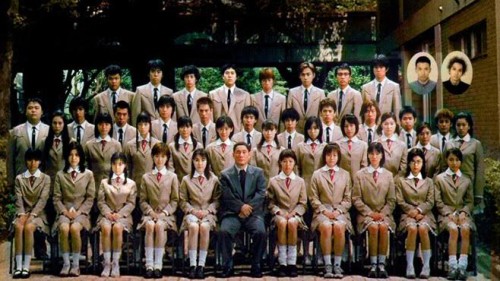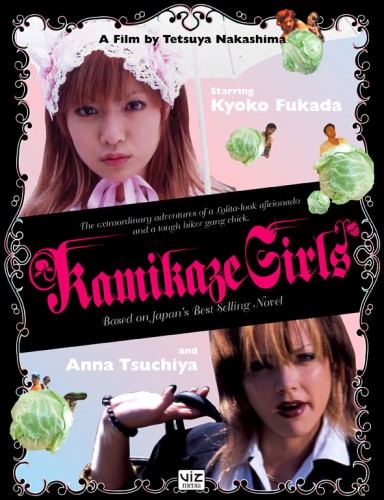This guest post by Belle Artiquez appears as part of our theme week on Dystopias.
We have all seen dystopian futures represented in film and literature: desolate landscapes with survivors of some war-torn/zombie apocalypse struggling to live their bleak lives under the rule of brutal and selfish dictators who are only out for themselves. It’s a theme we are well-accustomed to, and there are numerous examples of different dystopian futures: zombie apocalypses are in full swing at the moment in TV and film (The Walking Dead, The Last Ship, World War Z), but then there is also the fall of religion (The Book of Eli), the loss of fertility (Children of Men), and the loss of resources such as water and oil (Mad Max).
The examples of how humanity could fall are in such abundance that when we get a film that doesn’t necessarily look that different to our own current world, it may not be the harsh dystopian world that we are so used to seeing on screen. Battle Royale (2000) is that film, and yet its reality is somewhat harsher than these other dystopian themes. Directed by Kinji Fukasaku, and adapted from a book of the same title, the apocalyptic film portrays a totalitarian government that rules Japan, where communication with the western world is forbidden, and every year one school class is chosen to be pitted against each other in the ultimate fight to the death as a way of controlling the young generations and reminding them that they cannot rebel, they cannot be free, and they will only ever be restrained by their government.
The actual Battle is set on a highly guarded, isolated island, and the chosen class (a ninth grade class) is brought to it and ordered to fight in a zero sum game of death in a highly publicized slaughter game where there will be only one winner. The children are given one weapon each ranging from sauce pans to rifles and survival gear with maps and other necessities as they navigate through the island, of which there are interchangeable “forbidden zones.” Around their necks, a collar with the power to instantly kill is fitted to make sure any student disobeying the rules or being in a death zone at the wrong time will be killed. It appears to all to be a completely unfair setup, but this is a harsh dystopian world, so what do we expect?

Not only does the film portray existing anxieties for Japan, it also represents the severe landscape of our current era–the fact that people struggle to survive already, that some are unfairly given better opportunities regardless of value (portrayed through the weapons the students are given) and are almost set up for failure. The fact that a ninth grade class is always the chosen class depicts the hardship and suffering of actual ninth grade classes in Japan currently. Up until that grade, students need only be in attendance to proceed to the next grade, but suddenly at ninth grade they are faced with extremely difficult exams in order to get a placement in a more prestigious school, putting immense pressure on students who are suddenly pitted against each other for these few places. Apart from this obvious nod, the film also suggests that we are already currently set up for failure worldwide. Our banking system for instance is the biggest fraud of our time, where people are given loans of money that doesn’t actually exist only to have to work even harder to repay the non-existent money back with actual hard cash. We are told that we need to earn a living doing jobs that we hate, instead of living and doing what makes us happy. We are born into constant monitoring, not being able to move around the world without asking permission or being watched. Governments may not be totalitarian, authoritarian ones but they certainly act in similar ways under the guise of protectors. These are all aspects of what the students of Battle Royale have to cope with. They are watched not only by the controllers of the battle, but by the entire country, as if nothing more than a reality show.
The “Forbidden Zones” also illustrate the ways in which laws are put in place. We know that most laws are put into place for our benefit–murder, theft, and abuse are all illegal for the good of the people–so that we feel safe in our day-to-day lives. However, governments have been known to create laws for their own benefit, take for example the new law created in Australia that states it is illegal for detention centre workers to report child abuse, rape and human rights violations. Or the American law that states it is illegal to film and report animal abuse on farms, establishing severe criminal sanctions for those who would report the abuse as opposed to those causing the abuse. These laws are not in place to protect the people, they are conceived in order to protect the corporations in charge, the authorities. This use of law-making is of course related to the “Forbidden Zones,” which are set up so the game will run within the three day time limit, and also for the entertainment of viewers watching from the safety of their homes. The students have not only to fight and kill their classmates with whatever they were given but they also have to worry about where they go, at what times.
The leader and man in charge of the battle is also the representative of our current powers/governments/politicians. Kitano is the man who tells the students the rules of the game, as well as handing them their weapons and survival gear, and who likewise has no problem killing two students before stating it is actually against the rules for him to do so. By breaking the rules in such a nonchalant manner Kitano shows the class that they must obey a hypocritical generation in order to survive. He even goes as far as asking the students to be friends with him, establishing a false sense of security, the contrast between being friends with this man and then witnessing him kill two of them is stark and also conveys the same governmental control that most countries understand, the “We are here to help you” attitude while they only ever help themselves. Another facet of this dynamic relationship refers to the fact that the classmates are all friends with histories and memories together and now they must let go of all of that and slaughter each other. However, not all students have the ability to do this and end up committing suicide as a way out of this and also as an escape of the imminent betrayal they will face.

And just as the film articulates these contrasting attitudes and dilemmas with regard to controlling powers and zero sum attitudes, so too does it address these issues within themes of gender, sexuality and authority. Battle Royale does stereotype its female and male characters to conform to society’s ideas of femininity and masculinity. Most of the women are rendered weak, helpless, and in need of protection. Where some girls need the help of their male friends to survive (Noriko, whose protection is passed on when her initial protector is killed), others cling to each other in the hopes that some sort of sisterhood will unite them and make them strong enough to survive, showing a kind of stupidity on their part since there can only be one winner. These united girls end up in anarchy as one of them eats a poisoned dinner meant for a male classmate and suddenly they are all slaughtering each other without even trying to overcome the misunderstanding. In total contrast to this we see male students working together in perfect harmony even with a few moments of misunderstandings as a few of them work together to get the death collars deactivated. The male characters do their best to protect the female students, but only the ones that have strong emotional relationships with the men.

The only strong female character also happens to be presented as the villain of the piece (as does the previous winner of the game who happens to be a young girl, although we only see her briefly at the beginning), and this is possibly because she is independent, sexual, and in control. Mitsuko is violent, she quickly becomes a killing machine in order to survive, and even uses her sexuality to do so. A loner in her class before the slaughter, a victim of sexual abuse and a murderer at a young age (in self defense against the man who was going to abuse her), she now just “doesn’t want to be the loser anymore” and uses everything at her disposal to win. This includes her obvious sexuality, which she uses in ways similar to a Venus fly trap. A good deceiver, she entices a two male classmates and while they feel at ease, happy to be getting any sexual action, she kills them. Now who’s at fault for this? The girl who was just playing the brutal game like all the other students in order to survive, or the boys who stupidly thought that sex was worth the risk? Yet Mitsuko is the villain, which may actually just be another acknowledgment of current gender expectation in Japan, which is where the film and book are based on after all. Gender roles are an important part of Japanese society: men are expected to work hard, and housewives are considered valuable for their child rearing abilities; this could be why we see the group of girls acting in ways similar to the housewife, while the male students work to either outright win the game or fight the authority by breaking the collars. Traits associated with individualism such as assertiveness and self-reliance is not seen in high regard, which is why we are shown Mitsuko in a negative, villainous way. So for a film that nearly entirely describes our current living situation, it could be said that the gender roles and stereotypes too are another way of acknowledging existing gender positions and expectations in Japan.

This is certainly a terrifying film; we are presented with a nightmarish portrayal of a hyper-violent, dystopian, totalitarian world we would be afraid to be a part of, yet we are also delivered a unique depiction of the word we are already a part of and that in itself is the most nightmarish aspect of Battle Royale. The film is an acknowledgment of not only the world we live in right now but also of the human condition and the gender roles that are currently prevalent in a society that is supposed to be based on equality; however, it is anything but. We need to look to such films and recognise that although they are fictional, and depictions of a harsh dystopia, they are also reflections of our present issues in society. They are showing us how bleak and grim our own realities are without the slaughter games and authoritarian powers that make the Battle Royale world so frightening.

Further reading:
“Dangers of Governmental Control”
“Violence in Contemporary Society and Battle Royale”
Belle Artiquez graduated from film and Literature studies in Dublin and since has continued her analysis and critique of film, TV, and literature (mainly in the area of gender politics and representations) as well as cultural and societal critiques on such blog spots as Hubpages and WordPress.





